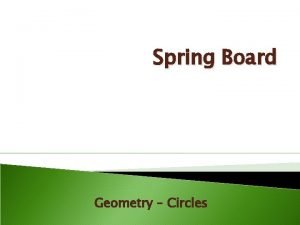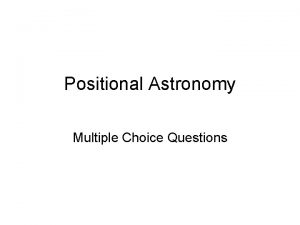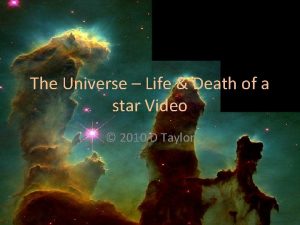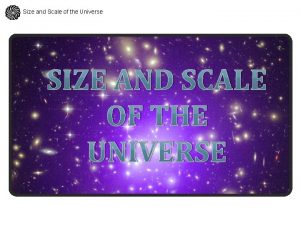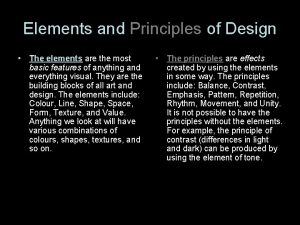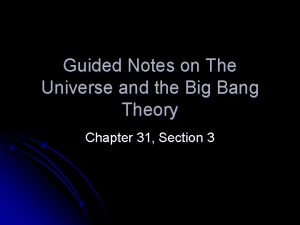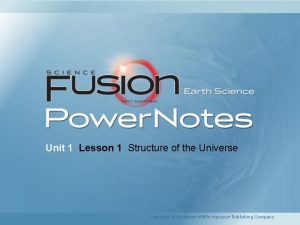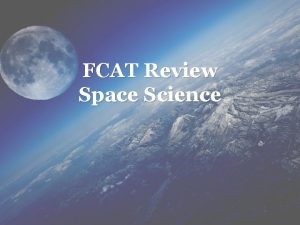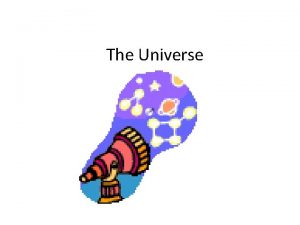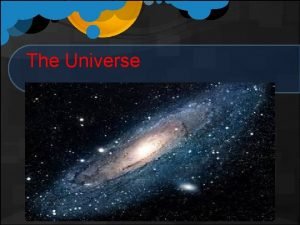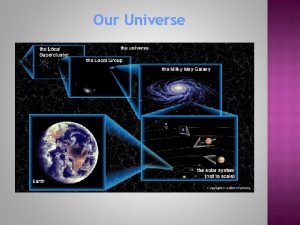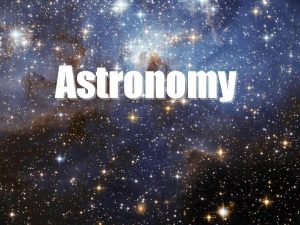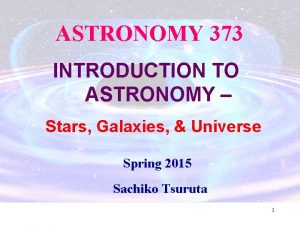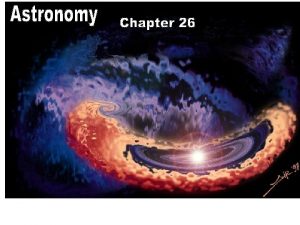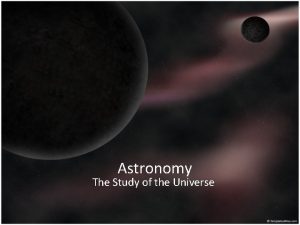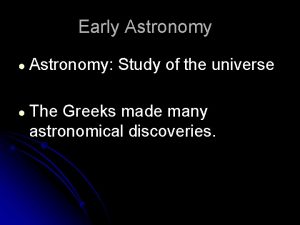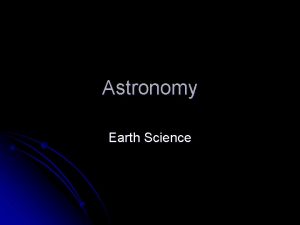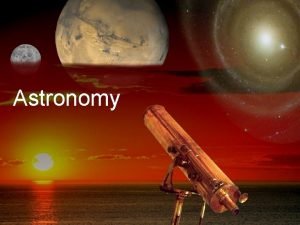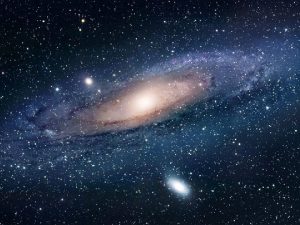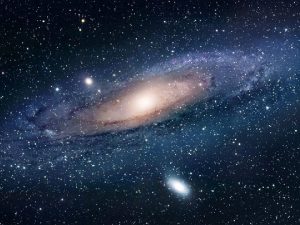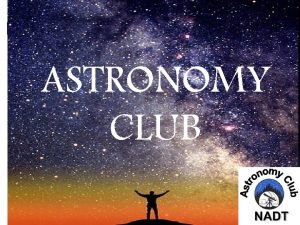FCAT Review 1 Astronomy Universe Space and all
































- Slides: 32

FCAT Review # 1 - Astronomy

Universe - Space and all of the matter and energy that is in it.

UNIVERSE GALAXY STARS SOLAR SYSTEMS PLANETS

*Galaxy – a massive system of stars, gases, dust, and other matter held together by a central gravitational force

Spiral Elliptical Irregular

*Stars – large spherical(round) bodies composed of gas (H, He) and gives off light The Sun Sirius Betelgeuse Aldebaran Regulus

*Solar System – a central star with planets and other small objects orbiting it

*Planet – a spherical body that orbits a star

Measuring Distances in the Universe

*Astronomical Unit (AU’s) – the distance from Earth to the Sun --used to measure distances in the Solar System

*Light year – the distance light travels through space in 1 year of time (measures distances in the rest of the Universe) - From Earth to stars - The size of galaxies - From galaxy to galaxy

Size of Stars

*The color of a star indicates its temperature Blue (Hottest) Red (Coolest)

*Apparent Magnitude - How bright a star appears to be from Earth Star Apparent Magnitude The Sun -26. 8 Sirius -1. 46 Vega +0. 03 Betelgeuse +0. 5 *The smaller the number (value), the brighter the star appears

Absolute Magnitude (Luminosity) – How bright a star actually is Star The Sun Sirius Vega Rigel Betelgeuse Apparent Magnitude -26. 8 -1. 46 +0. 03 +0. 12 +0. 5 Absolute Magnitude +4. 8 +1. 2 +0. 6 -8. 1 -7. 2 *The smaller the number (value), the brighter the star actually is

� Models of the Solar System

*Geocentric Model – Earth in the center

*Heliocentric Model – Sun in the center

Structure of the Sun Core where energy is produced through the process of fusion

Structure of the Sun Photosphere the visible surface of the sun *approx 300 miles thick *takes 8 minutes for light to reach the Earth

The Sun’s Rotation – Differential Rotation *Different parts of the sun rotate at different rates of speed (the sun is a ball of gases , not solid like the Earth

SOLAR ACTIVITY Solar Flare an explosive burst of energy extending out from the sun *appears as very bright spots on the photosphere *Similar to a volcanic eruption on Earth

SOLAR ACTIVITY Prominence huge loops of gases extending out from the sun *many Earths could fit inside one

SOLAR ACTIVITY Sunspots dark areas that form on the sun’s surface *cooler regions of the photosphere caused by a change in the sun’s magnetic field

*How does solar activity affect conditions on Earth? *Solar flares can affect satellites, astronauts, GPS systems, jet airplanes, and electrical systems and devices on Earth.

1 - Inner Planets (Terrestrial) *Small *Rocky *Closer to the Sun

2 - Outer Planets (Gas Giants) *Large *Thick, gaseous atmospheres (hydrogen & helium) with a solid core *Fast rotational period *Many moons and rings *Farther away from the Sun (colder)

1. Dwarf Planet *A round object that orbits the Sun, but has other objects that cross its orbit PLUTO

2. Natural Satellites (Moons) *A round object that orbits a planet *Why does Jupiter and Saturn have so many satellites? *They have a stronger gravitational pull on objects

3. Asteroids *Chunks of rocks & metal orbiting the Sun

5. Comets *An icy body that releases glowing gases as it orbits close to the Sun Coma Tail

What is the universal force that hold galaxies together, caused a nebula to collapse inward and flatten into a disk that eventually formed our solar system, and keeps objects in orbit around other objects? Gravity
 Learning astronomy by doing astronomy
Learning astronomy by doing astronomy Learning astronomy by doing astronomy activity 1 answers
Learning astronomy by doing astronomy activity 1 answers Learning astronomy by doing astronomy activity 1 answers
Learning astronomy by doing astronomy activity 1 answers Fire safety writing prompts
Fire safety writing prompts Brainpop strengthening sentences answer key
Brainpop strengthening sentences answer key Fcatexplorer.com
Fcatexplorer.com Fcat star
Fcat star Earth science jeopardy 8th grade
Earth science jeopardy 8th grade Fcat vs fsa
Fcat vs fsa Fcat reference sheet
Fcat reference sheet Opposite rays
Opposite rays Astronomy questions and answers multiple choice
Astronomy questions and answers multiple choice Michigan state physics
Michigan state physics Figure of speech in far far from gusty waves
Figure of speech in far far from gusty waves Joint space vs cartesian space
Joint space vs cartesian space Space junk the space age began
Space junk the space age began Camera space to world space
Camera space to world space Cartesian space vs joint space
Cartesian space vs joint space World space computer
World space computer What is the answer to life the universe and everything
What is the answer to life the universe and everything Chapter 30 galaxies and the universe
Chapter 30 galaxies and the universe Death of a star video
Death of a star video The scale of the universe
The scale of the universe Steve magada trio
Steve magada trio Guided notes on the universe and big bang theory
Guided notes on the universe and big bang theory Structure and evolution of the universe. lesson 1
Structure and evolution of the universe. lesson 1 Sunnatullah
Sunnatullah Chapter review motion part a vocabulary review answer key
Chapter review motion part a vocabulary review answer key Writ of certiorari ap gov example
Writ of certiorari ap gov example Nader amin-salehi
Nader amin-salehi Prisma diagram example
Prisma diagram example Narrative review vs systematic review
Narrative review vs systematic review She's all states and all princes i nothing else is
She's all states and all princes i nothing else is









